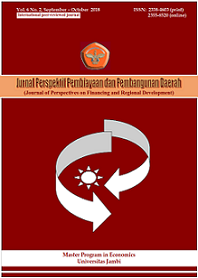Sustainability of post-mining land use and ecotourism
DOI:
https://doi.org/10.22437/ppd.v6i2.5441Abstract
The mining sector can contribute to the state in the form of foreign exchange and state in the form of foreign exchange and funding sources such as royalties, taxes, the expansion of employment and physical development, on the other hand, led to some social and environmental conflicts. One effort to improve environmental conditions in the mining area through revegetation, reclamation and post-mining. Reclamation and post-mining activities must be under the EIA plan, FS, Plans Closure Reclamation and Mine Closure Plan to be used for sustainability and ecotourism. This study was conducted using a collaboration between study literature method and the AHP method. The purpose of this study was to determine the post-mining land use, preferred alternatives for utilization of post-mining land is done through the Analytical Hierarchy Process (AHP) method by analyzing the relationship between three criteria and alternatives. The criteria are selected based on the ecological, socioeconomic and cultural aspects. This is based on the consideration of sustainability and spatial planning. In addition, the alternatives that will be considered as utilization strategies include the efforts to increase the land use.. Secondary data analysis resulted that known to the utilization of post-mining land from various companies such as: the use of pits (void) into water treatment, aquaculture and ecotourism, the usage of land reclamation and mine closure in the form of plateau used as cultivation flora and fauna depends on the utilization zone, which has approved the EIA Document, FS, Plans Closure Reclamation and Mine Closure Plan.
Downloads
References
Adaro Indonesia. (2010). Coal Added Value for Sustainability. Sustainability report 2010: Sustainability Report.
Adaro Indonesia. (2013). Delivering Positive Energy Sustainably. Sustainability Report 2012-2013.
Arif, I. (2007). Perencanaan Mine Total Settlement Efforts Environmental Issues as World Mining University of Sam Ratulangi, Manado.
Cooper, A., Shine, T., McCann, T., Tidane, D.A. (2006). An ecological basis for sustainable land use of Eastern Mauritanian wetlands. Journal of Arid Environments, 67, 116-141.
Creswell, J.W. (2013). Research Design: Qualitative Approach, Quantitative and Mixed. Yogyakarta: Student Library.
Dewi, R. (2011). Landscape Planning for the Development ofNature in
BorderKemiri River District of Margadana - Tegal City. PSMILUNPAD.
Gunawan, A., Jaya, I.N.S., Saleh, M.B. (2010). Quick techniques in identifying Open Area by the Use of Multi-Spatial and Multidate Imageries. Journal of Tropical Forest Management, 16(2), 63-72.
Hartman, L. H. (1987). Introductory Mining Engineering. Canada: John Wiley & Son, Inc.
Hu, D., Yang, G., Wu, Q., Li, H., Liu, X., Niu, X., Wang, Z., Wang, Q. (2008). Analyzing Land Use Changes in the Metropolitan Jilin City of Northeastern China Using Remote Sensing and GIS. Sensors 8, 9, 5449 -5465. doi: 10.3390 / s8095449.
Kaltim Prima Coal. (2015). Membara Untuk Indonesia. Sustainability Report 2015
Kaltim Prima Coal. (2016). Nyalakan Semangat Bersama Igniting Resolution. Sustainability Report 2016
Mansur, I. (2012). Integrating Biodiversity Conservation and Agricultural Production in Mine Reclamation for Sustainable Development. Journal of Developments in Sustainable Agriculture, 7, 97-102.
Nurcahyani, T. (2011). Kajian Pemanfaatan Lubang Bekas Tambang (Void) di Adaro Indonesia, Provinsi Kalimantan Selatan. Program Studi Ilmu Lingkungan, University of Indonesia.
Peterson, G. D., Heemskerk, M. (2001). Deforestation and forest regeneration following small-scale gold mining in the Amazon: the case of Suriname. Environmental Conservation, 28(2), 117-126.
Robertson, A., Shaw, S. (n.d.). Mine Closure. Info Mine E-book
Ross, S., Wall, G. (1999). Ecotourism Towards Theory and Practice. Tourism Management.
Sandin, L. (2009). The relationship between land-use, hydromorphology and river biota at different spatial and temporal scales: a synthesis of seven case studies. Fundamental and Applied Limnology, 174(1), 1-5.
Trisasongko, B. H., Panuju, D. R., Iman, L. S., Harimurti, V. A., Ramly, A. F., Subroto, H. (2009). Analisis Dinamika Konversi Lahan di Sekitar Jalur Tol Cikampek. Publikasi Teknis DATIN, Kementerian Negara Lingkungan Hidup.
Tuni, M. S. (2013). Perencanaan Penggunaan Lahan Pascatambang Nikel untuk Mendukung Pengembangan Wilayah di Kabupaten Halmahera Timur. Tesis Program Studi Pertanian, Institut Pertanian Bogor.
Tuni, M. Z. (2013). Perencanaan Penggunaan Lahan Pascatambang Nikel Untuk Mendukung Pengembangan Wilayah Di Kabupaten Halmahera Timur. Tugas Akhir Program Studi Ilmu Perencanaan Wilayah Departemen Ilmu Tanah dan Sumber Daya Lahan, Institut Pertanian Bogor.
Undang-undang Nomor 4 Tahun 2009 tentang Pertambangan Mineral dan Batubara
Undang-Undang Nomor 41 tahun 1999 tentang Kehutanan
Zhang, et. al. (2011). Land Use-Based Landscape Planning and Restoration in Mine Closure Area. Springer Science Buisness Media.
Zhang, J. J., Fu, M. C., Tao, J., Huang, Y., Hassani, F. P., Bai, Z. K. (2010). Response of ecological storage and conservation to land use transformation: a case study of a mining town in China. Ecological Modelling, 221, 1427–1439.
Downloads
Published
How to Cite
Issue
Section
License
Copyright (c) 2018 Herdis Herdiansyah, Marikha Ulfah Utami, Joko Tri Haryanto

This work is licensed under a Creative Commons Attribution 4.0 International License.

















